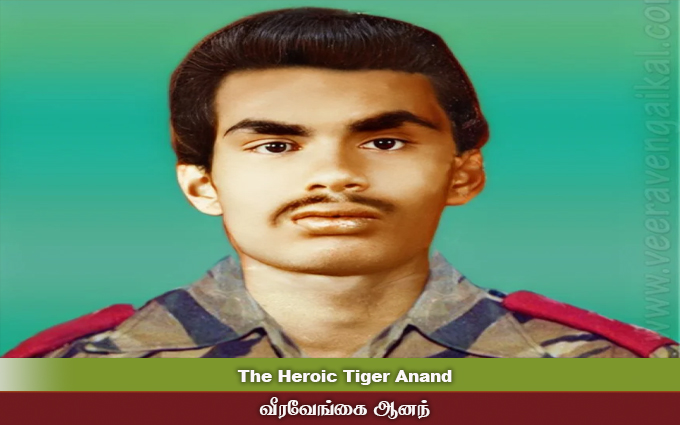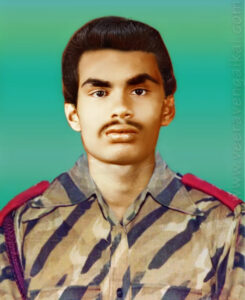

The Heroic Tiger Anand

The Heroic Tiger Anand
On July 15, 1983, a new young guerrilla fighter named Anand, also known as Arulnathan, was introduced to the world by the Tamil Eelam Liberation Tigers. Arulnathan became a fierce fighter who, in the soil of Meesalai, took up arms and fought the Sinhala army mercenaries until his last breath.
With blood flowing from his chest, Anand saw another guerrilla fighter next to him follow Seelan’s command of “Shoot me” as Seelan’s head was hit by a bullet. In the blink of an eye, the mercenary bullets also struck down Anand.
Seelan, the leader of the guerrilla group, was being hunted by the state military. He had led the guerrilla attack on the Chavakachcheri Police Station, something the Sinhala mercenaries were well aware of. As a senior member of the Liberation Tigers of Tamil Eelam, Seelan could never be captured by the mercenary forces.
Seelan, who had the experience to think of disappearing, likely had the mental strength to escape. But Anand, who had been with the organization for less than seven months and had just completed arms training, showed a purity of idealism that makes us shiver. He asked his fellow fighter to shoot him to protect the organization’s secret.
That young man who set foot on the revolutionary armed path of the Tigers with confidence and determination probably dreamed of seeing many battlefields. But fate did not give this brave hero the chance to demonstrate those feats. Unfortunately, Anand embraced death before reaching the age of nineteen.
Anand had a well-built body that looked beyond his years. His mustache was grown, and his words came from deep within his throat. He never got angry with anyone and was known for his accommodating nature with his friends. He was ready to do any work without seeing it as beneath him, whether cooking or digging a well.
He preferred wearing light blue clothes. Anand, a valiant son of the Mayilitti land, received his primary education in Negombo. He later studied at Jaffna College in Vattukottai and Hindu College in Manipay. Anand studied science in the advanced level of the General Certificate of Education (GCE) and later embraced politics as his life’s calling.
During his school days, Anand was an excellent athlete. He gained fame as an outstanding goalkeeper in his school football team and was also a skilled cricket player. Additionally, he learned karate and had the ability to drive all kinds of vehicles with precision. Even in his short period of arms training, he acquired extensive knowledge of weaponry. He had sufficient chemical knowledge to manufacture bombs, and during shooting practice, he could quickly and accurately hit his targets.
 Whenever he hit a bullseye, he would raise his hands and laugh with the pride of a schoolboy, exclaiming “Hey!” (We don’t need to be confused by dismissing this talent as mere adventure; it’s a key skill for a guerrilla fighter who never misses his target.) In guerrilla attacks against a powerful military equipped with superior weapons, fighters with such skills play a crucial role. When J.R. Jayawardene boasted about defeating the Tigers in the North, the successful Liberation Tigers’ attack against government forces in May 1982 in Nelliady clearly demonstrated that a guerrilla struggle cannot be easily suppressed.
Whenever he hit a bullseye, he would raise his hands and laugh with the pride of a schoolboy, exclaiming “Hey!” (We don’t need to be confused by dismissing this talent as mere adventure; it’s a key skill for a guerrilla fighter who never misses his target.) In guerrilla attacks against a powerful military equipped with superior weapons, fighters with such skills play a crucial role. When J.R. Jayawardene boasted about defeating the Tigers in the North, the successful Liberation Tigers’ attack against government forces in May 1982 in Nelliady clearly demonstrated that a guerrilla struggle cannot be easily suppressed.
Following this attack by the Tamil Tigers against the Sri Lankan army, Anand became a symbol of hope for the Tamil Eelam people, representing the faith that arose in their hearts. In early June 1982, Anand established contact with the Liberation Tigers of Tamil Eelam (LTTE). However, even before joining the LTTE, Anand had connected with members of other freedom fighters groups and learned about their activities. Many of them turned out to be merely talkers, while others provided false information. Realizing that these people were not genuine, Anand fully dedicated himself to the Liberation Tigers. Our organization takes great pride in the ideological purity and commitment of its members.
Though Anand came from a wealthy family, the revolutionary fire that burned within him secured him a permanent place in the history of Tamil Eelam’s struggle.
Anand, who had two sisters and two brothers, opened his heart widely to the millions of people longing for freedom. On July 5, 1983, under the leadership of Seelan, the Liberation Tigers, armed with weapons, infiltrated the Kankesanthurai Cement Factory.
In the blink of an eye, they took control of the guards and the timekeeper. All the guards of this cement factory, which was under the administration of Sinhala extremist Cyril Mathew’s ministry, were Sinhalese.
Anand, who had lived in Negombo for a long time and was fluent in Sinhala, spoke in Sinhala to the trembling guards.
“We are not enemies of the Sinhala people. We are only opposing the oppressive measures of the Sinhala government. If we were enemies of the Sinhala people, it wouldn’t take long for us to blow you up.”
It is not surprising that Anand, who grew up in a place like Negombo, which was constantly subjected to the daily oppression and bullying of the Sinhalese, developed a sense of hatred towards them. However, he had very clear views on the national ethnic issue of the Tamil people. Anand was familiar with some Sinhalese friends even among the guerrilla fighters of the LTTE, which was one of his notable traits. He was not drawn to Tamil Eelam politics by empty stage speeches. He also didn’t possess the narrow-minded attitude often seen in some others. Anand spent a lot of time interacting with ordinary Sinhalese people in Negombo. His close friends have said that when he spoke Sinhala, it sounded just as natural as how the Sinhalese themselves spoke. Anand, who jumped into the field for the Tamil people’s right to national self-determination, was never a Sinhalese hater.
On that night, when the LTTE fighters were transporting explosives and other equipment from the Kankesanthurai Cement Factory, they passed Kokkuvil in a Delica van just after midnight, and the back wheel punctured.
At this time, the incident must have already been reported to the police stations from the Kankesanthurai factory. After delivering the explosives to their destination, they had to return the Delica van to its owner.There was nothing to jack up the van or remove and replace the tire. Anand stepped forward and said, “There are so many of us here. Each one of you lift the van, and I’ll change the tire.”
Yes, within a few minutes, the new tire was fitted, and the van sped off like lightning.
Around May 1983 Seelan and Anand were both working on the task of boycotting local government elections. They played a major role in the military action against the three candidates who came forward to contest the election on behalf of the United National Party. After the death of Anand the Sinhala military identified him and shouted and behaved inhumane towards Anand’s father. He kept his calm when they shouted and yelled. He thought in his silent mind of his son, who would always accompany Seelan on his bicycle ever since Seelan had his leg injurie and now, even in death, Anand accompanied Seelan.
Anand’s time in the movement was short, though his willpower, strength, and perseverance states a good example for others to follow.
Anand!
You were only nineteen years old.
But…
You will live for thousands and thousands of years in every hearts that burns for revolution!